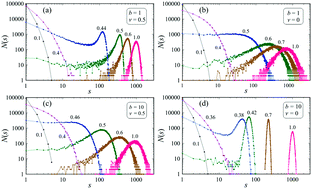当前位置:
X-MOL 学术
›
Phys. Chem. Chem. Phys.
›
论文详情
Our official English website, www.x-mol.net, welcomes your
feedback! (Note: you will need to create a separate account there.)
Aggregation and fragmentation in liquids with dispersed nanoparticles
Physical Chemistry Chemical Physics ( IF 2.9 ) Pub Date : 2018-06-26 00:00:00 , DOI: 10.1039/c8cp01594e Wojciech Jeżewski 1, 2, 3, 4
Physical Chemistry Chemical Physics ( IF 2.9 ) Pub Date : 2018-06-26 00:00:00 , DOI: 10.1039/c8cp01594e Wojciech Jeżewski 1, 2, 3, 4
Affiliation

|
Nanoparticle-induced aggregation and fragmentation phenomena in liquid media are investigated by applying a model of preferential attachment of dispersing molecules to randomly chosen nanoparticles and larger particles, each containing a single nanoparticle. The model is based on the assumption that immersed nanoparticles, media molecules, and the resulting composite particles do not form any self-linked structures, i.e., that they do not undergo homoaggregation as a consequence of, e.g., electrostatic repulsion. Probabilities of both connecting and disconnecting a molecule are considered as being proportional to the surface area of a target particle. Additionally, the aggregation probability is assumed to be driven by van der Waals interactions. The interplay between aggregation and fragmentation processes is studied for different relative efficiencies (frequencies) of these processes. In particular, the time evolution of the particle size distribution is analyzed at various values of the relative frequency rate between aggregation and fragmentation events. It is shown that the evolution of an ensemble of particles over relatively long time periods can lead to very peculiar particle size distributions, including nearly homogeneous and highly heterogeneous partitioning. This indicates that, by controlling the frequency rate, one can obtain materials with very diverse and unique properties. Theoretical results obtained within the studied model are compared with corresponding experimental data.
中文翻译:

具有分散的纳米粒子的液体中的聚集和破碎
通过将分散分子优先附着到随机选择的纳米粒子和较大粒子(每个粒子都包含一个纳米粒子)模型上,研究了纳米粒子在液体介质中引起的聚集和破碎现象。该模型基于以下假设:浸没的纳米颗粒,介质分子和所得的复合颗粒不会形成任何自连接结构,即,它们不会由于以下原因而发生均聚:,静电排斥。连接和断开分子的概率都被认为与目标粒子的表面积成正比。另外,假定聚集概率是由范德华相互作用驱动的。针对这些过程的不同相对效率(频率),研究了聚集过程和碎片过程之间的相互作用。特别地,在聚集和破碎事件之间的相对频率速率的各种值下分析粒度分布的时间演变。结果表明,在相对较长的时间段内,整体粒子的演化会导致非常特殊的粒度分布,包括近乎均匀和高度不均匀的分配。这表明通过控制频率速率,人们可以获得具有非常多样化和独特特性的材料。将在研究模型中获得的理论结果与相应的实验数据进行比较。
更新日期:2018-06-26
中文翻译:

具有分散的纳米粒子的液体中的聚集和破碎
通过将分散分子优先附着到随机选择的纳米粒子和较大粒子(每个粒子都包含一个纳米粒子)模型上,研究了纳米粒子在液体介质中引起的聚集和破碎现象。该模型基于以下假设:浸没的纳米颗粒,介质分子和所得的复合颗粒不会形成任何自连接结构,即,它们不会由于以下原因而发生均聚:,静电排斥。连接和断开分子的概率都被认为与目标粒子的表面积成正比。另外,假定聚集概率是由范德华相互作用驱动的。针对这些过程的不同相对效率(频率),研究了聚集过程和碎片过程之间的相互作用。特别地,在聚集和破碎事件之间的相对频率速率的各种值下分析粒度分布的时间演变。结果表明,在相对较长的时间段内,整体粒子的演化会导致非常特殊的粒度分布,包括近乎均匀和高度不均匀的分配。这表明通过控制频率速率,人们可以获得具有非常多样化和独特特性的材料。将在研究模型中获得的理论结果与相应的实验数据进行比较。











































 京公网安备 11010802027423号
京公网安备 11010802027423号